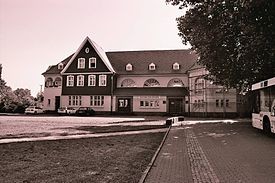Railway Station Dahlhausen

The railway station is situated in Bochum's district of Dahlhausen. The station building stems from the time of the First World War.
Since the 1st of September 2009, the monument is as an intercultural joint project of the non-profit prokulturgut. net e.V. and the city of Stadt Bochum as ONE WORLD STATION: Railway Station Dahlhausen - HAUS DER KULTUREN RUHR (House of Cultures Ruhr) being operated. In the frame of the culture Capital 2010, the historical building with forecourt became the new venue of the Ruhr festival 'Extraschicht'.
Today the railway station Dahlhausen has three tracks on two platforms. The tracks 1 and 2 are used mostly by the regular rail traffic, while track 3 serves the museum's traffic of the Ruhrtal Train.
History
Industrialisation
The beginnings of the station, go back to the year 1863, when the Bergisch-Märkische Eisenbahn-Gesellschaft opened a branch line from Essen-Überruhr via Essen-Steele Ost (former Steele main train station) to Dahlhausen on the 21th of September of that year.
The freight transport had priority, but on working days passenger carriages were attached. When the line was extended to Hattingen in 1866, Dahlhausen got a little station building. On the 10th of October 1870, the 'Hasewinkel coal line' was opened as a normal gauge line.
The communities Dahlhausen and Linden participated in the construction of a new station building, which was completed in 1875. At that time, the Ruhrtal train run all the way to Zu Hagen already. Thus, the building became soon too small.
Consequently the Royal-Prussian railway management Essen, planed a larger building in 1913. During the First World War the station was built with prisoners of war and solemnly inaugurated on the 28th of February 1917. In the years from 1916 to 1918, a depot was created here, whose importance for the freight traffic on the surrounding lines stayed local until its shutdown in 1969. And, only after the changing of the facility to a Railway Museum in 1977, it became supra-regional with the line Bochum-Dahlhausen.
Postwar Period
With the end of the Ruhr mining in the Ruhr valley the Ruhr valley railway also lost its importance. The depot Bochum-Dahlhausen was closed down in 1969.
The depot housed the railway museum Bochum-Dahlhausen already since 1977, the last completely preserved steam engine depot in Germany.
As, since 1974, only regional trains have used the line to Hattingen, the station building was closed in 1979. Finally, from 1994 onwards, the building was restored according to monument guidelines. An investor made it possible to restore the facade and roof in the form of Art Nouveau. The counter hall was recreated in the style of the 1920ties. The building housed at the end of the 1990ties, for a short time a public house, which operated under the name 'Dampflok'. But, due to a fire, the public house didn't restart in the historical station building.
In addition to the passenger train station in Dahlhausen, a railway yard also operated here, which has been completely demolished today. One part of the former track system was used to build a housing estate ('Ruhrauenpark'). The houses were completed in 2005.
The original text of this article is based on the Free Encyclopaedia Wikipedia http://de.wikipedia.org/wiki/Bahnhof_Bochum-Dahlhausen

